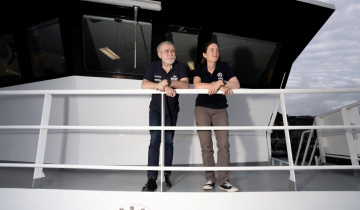The flotilla of icebergs currently off the South Island were probably once part of a much larger iceberg from the Ronne Ice Shelf, on the other side of Antarctica from New Zealand.
Dr Mike Williams, an oceanographer with NIWA, says in 2000, an iceberg 167 kilometres long and 32 kilometres wide broke off the Ronne Ice Shelf. This was named A-43.
A-43 subsequently broke into pieces. The largest piece, known as A-43A, was created in early May 2001, and is probably the ‘parent’ of the icebergs which are currently close to New Zealand.
The Ronne Ice Shelf borders the Weddell Sea, south of the Atlantic Ocean, in Antarctic territory claimed by Britain, Chile, and Argentina
‘A-43A was last spotted in the Scotia Sea, just to the north of the Weddell Sea, on 30 January 2005. That is about 13 500 kilometres away,’ says Dr Williams. ‘Based on A-43A’s last recorded position, and assuming it travelled the shortest possible route around Antarctica, we calculate an average speed of 0.9 kilometres per hour, or about 21.5 kilometres per day.’
Somewhere along the way, A-43A has broken into smaller pieces. ‘We have a satellite report from 30 January 2005 which estimates the size of A-43A at about 51 kilometres long and 21 kilometres wide. That’s about 360 times bigger than the largest piece the New Zealand Air Force spotted last week, and is consistent with the iceberg breaking up on its journey to New Zealand,’ says Dr Williams.
‘We believe A-43A drifted up past South Georgia Island. It would then have been swept along by the Antarctic Circumpolar Current and strong westerly winds around Antarctica. The iceberg – or icebergs – ended up slightly north of the usual track, and came between the Auckland Islands and Stewart Island where they were pushed into the Southland Current. The Southland Current runs up the east of the South Island to about mid-Canterbury before flowing out towards the Chatham Islands.’
The Antarctic Circumpolar Current is the world’s biggest current. It typically flows at the rate of about a quarter of a kilometre per hour, but can reach a top speed of seven kilometres per hour.
‘The track of this current crop of icebergs looks very similar to the route of an iceberg reported in 1931 off the Auckland Islands and then again off Dunedin. We would expect the icebergs to keep moving up the east of the South Island for a week or so. One or more of the larger ones may well break up further in that time.’








